Latest News
Kitchen Chat and more…
Kitchen Chat and more…

Guest Writer and his friends pictured together with Serge and Dave Broom
Written by Guest Writer
with input from 3 other whisky enthusiasts: Andreas Tassinari, Andrew Reid and Javin Chia.
According to the Scotch Whisky Association, France was the second-largest market by export value in 2018 (£442.1m). It edges out Singapore and beaten only by the US’ whopping £1,039.5m total. Hence it is no surprise that Whisky Live Paris is Europe’s largest whisky show and it not only attracts the French but international visitors too. This year saw a shift in venue to La Villette to accommodate the increasing numbers of visitors. With over 151 whiskies, rum and spirit booths, an additional 27 stands in the cocktail street and a host of masterclasses, the show was poised to impress.
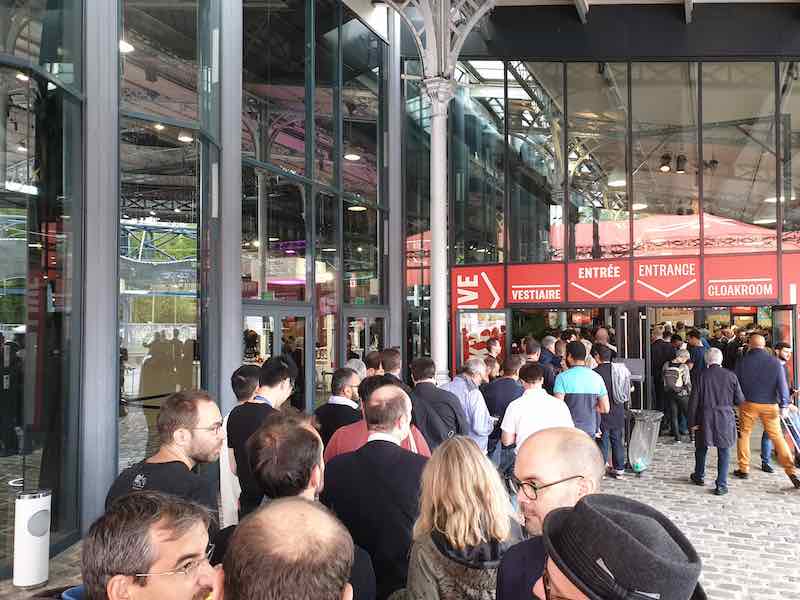
Check out the queue!
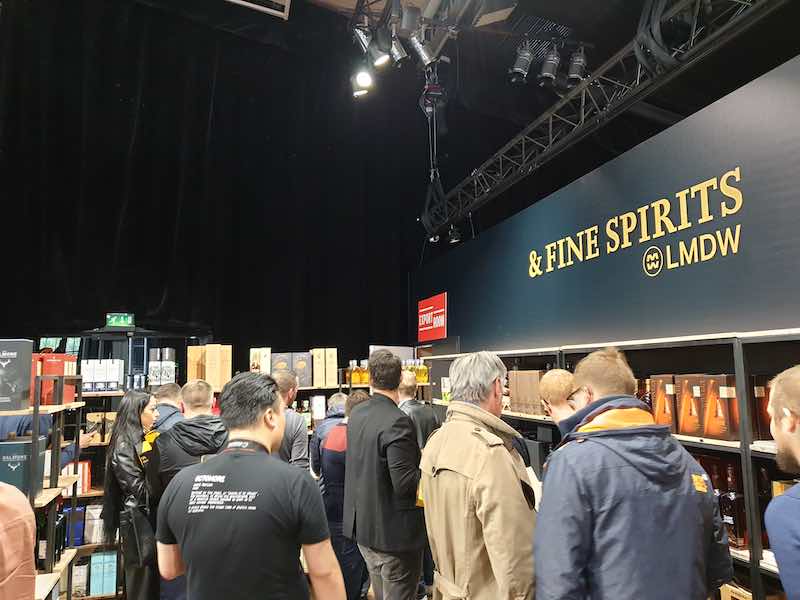
La Maison du Whisky Shop
The day started at 12.30 pm as visitors stormed the La Maison Boutique to grab the Chichibu Paris Edition 2019 and the Hampden Single Cask 7 years bottled for Whisky Live Paris. Visitors grabbed them in a matter of minutes! We were lucky to be able to get in the action at the shop to buy the bottles that we were after!
Below are some pictures of the various exclusive bottles available.
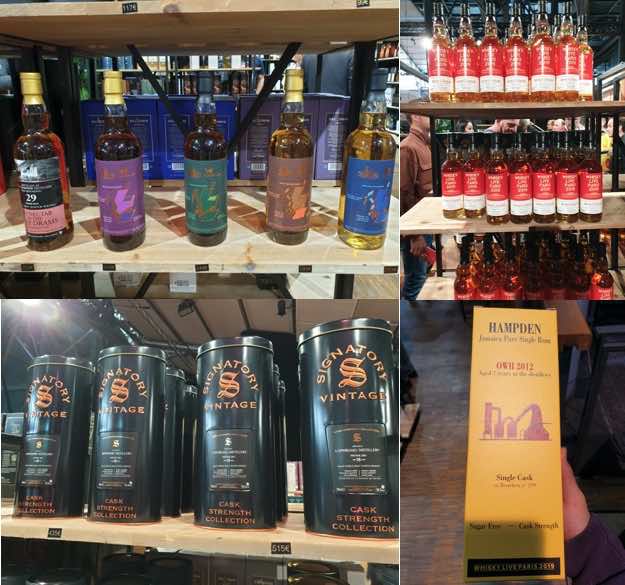
Whisky Live Paris Exclusive Bottles
After the stress of buying bottles among the crazed crowd, it was time for us to get to the fun part. With the promise of delicious whisky, we were looking forward to tasting them. In whisky shows, trying everything was impossible and blasphemous acts of pouring away and spitting out whisky was the norm to last the entire duration of the show.
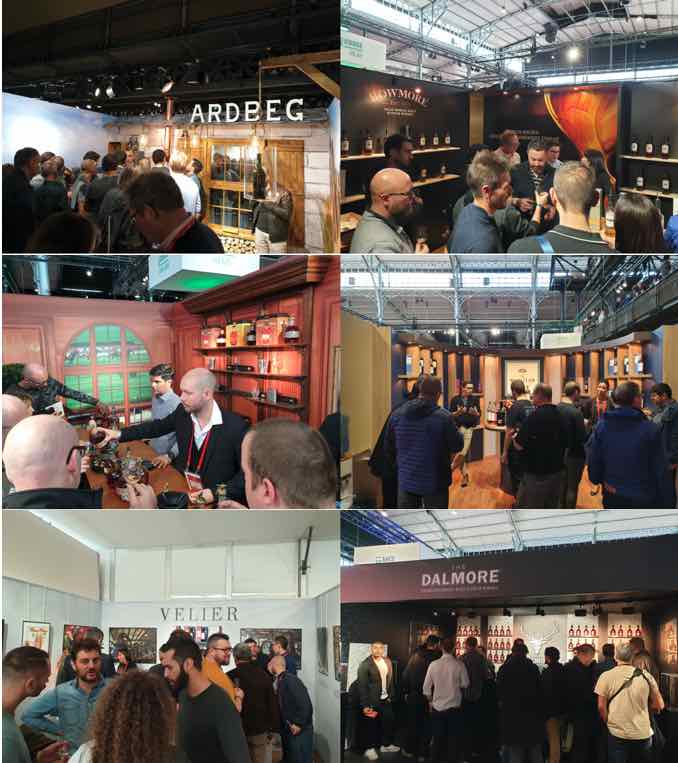
Various booths at WhiskyLive Paris
Many distilleries took the chance to showcase their newest releases at Whisky Live. Some notable ones included the revamped Arran Range, Compass Box Myths and Legends 1, 2 and 3. We also found Glenfiddich Grand Cru, Kilchoman Vintage 2010 9 Years, Macallan Edition 5 and Ardbeg 19 Traigh Bhan. Some distilleries also pulled off the stops to ensure that their booth stood out. Some used attractive displays; others covered stalls with curtains to create an ambience. Yet others chose to showcase chocolate pairings. Eager enthusiasts swamped several brands throughout the day (i.e. Macallan, Kavalan, all the Islay distilleries, Blanton’s, Velier).
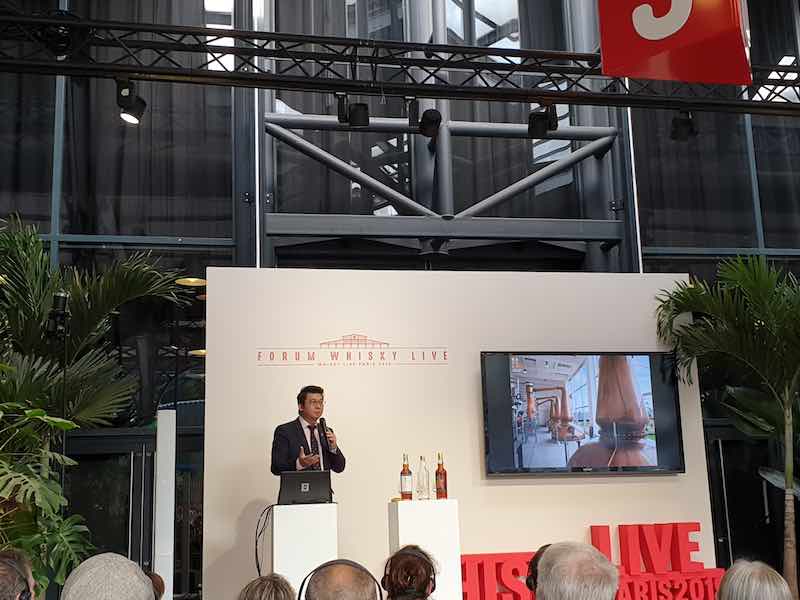
Kavalan’s Master Blender – Ian Chang
We attended Kavalan Master Blender Ian Chang’s Masterclass to start our day. Dr Jim Swan was Ian’s mentor and the man who was instrumental in the conception of Kavalan. He explained the exciting process behind Kavalan’s maturation process of first creating a heated and high humidity environment to intensify the colour. Next, the distillery would open the warehouse windows in the winter months to cool the interior and allow for wood aromas to infuse into the whisky.
Ian came across as an exceptionally down to earth and unpretentious man during his presentation. He even went as far as to say that the 11-year oloroso sherry single cask for LMDW was a bit over-oaked and that he should have taken the whisky out earlier. He was right. You won’t usually see master distillers or blenders throwing shade on their whisky, but this honest opinion was incredibly refreshing to see and is a testament to the distillery’s efforts to always strive for quality.
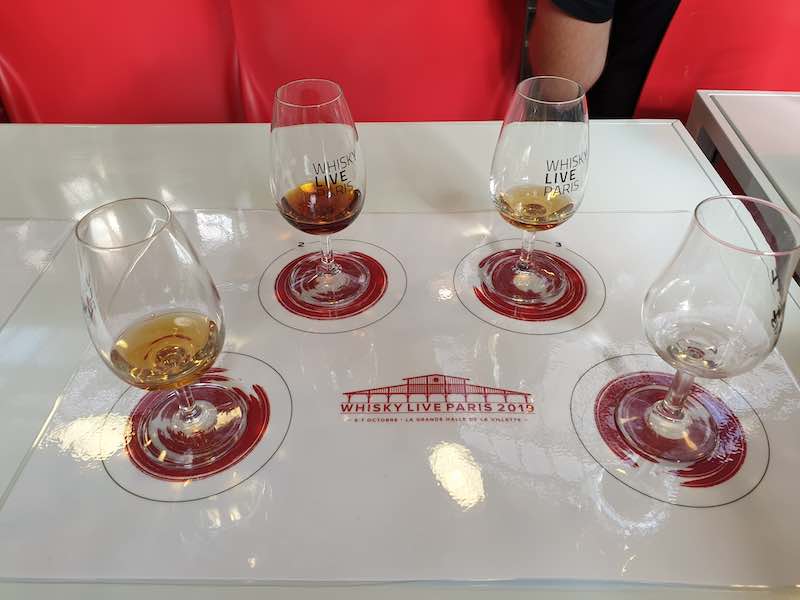
The Whisky Line-up at Kavalan Masterclass
The line up for the Masterclass was interestingly made up of single casks bottled for LMDW.
It is interesting to taste various casks from Kavalan to see how these casks impact and influence the spirits of Kavalan. Having the chance to meet Ian Chang was memorable too!
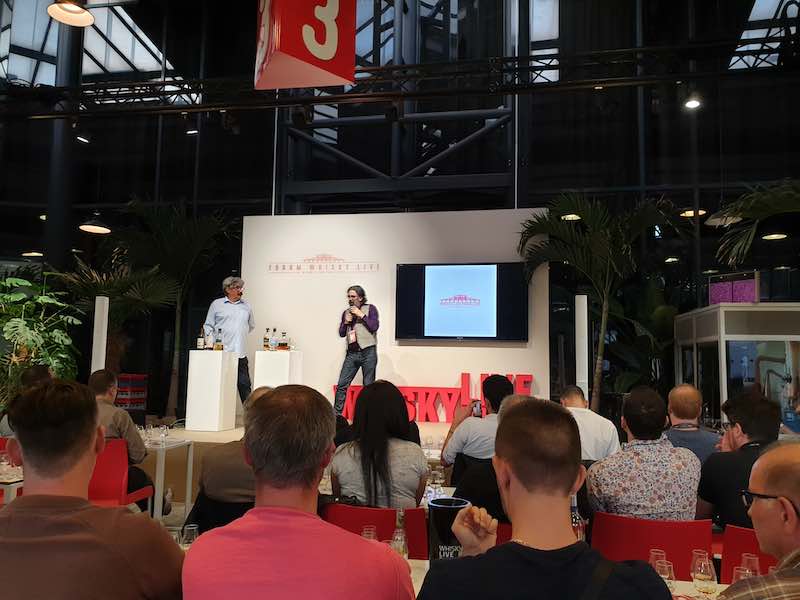
Serge Valentin (left) and Dave Broom (right)
It was an incredible opportunity to interact with what some would term the ‘stockbrokers’ of the whisky industry. Both Serge Valentin and Dave Broom reviewed whiskies using online platforms. Due to their heavyweight reputation in the industry, their scores for bottles are taken quite seriously, affecting the re-sale value or collectability. Technically, these scores should not define any whiskies for the whisky drinkers because tasting whisky is subjective. Nonetheless, the ratings are often, unfortunately, used by many to resell their bottles at much higher prices.
We thought it was terrific that LMDW invited both Serge and Dave to present their picks for Whisky Live Paris 2019. The mood was lighthearted on stage, with Dave jokingly saying that his choices were better than Serge. We found the tasting fun and fair as all attendees tasted the whiskies blind. We were also encouraged to guess the country of production, regions and distilleries through our blind tastings.
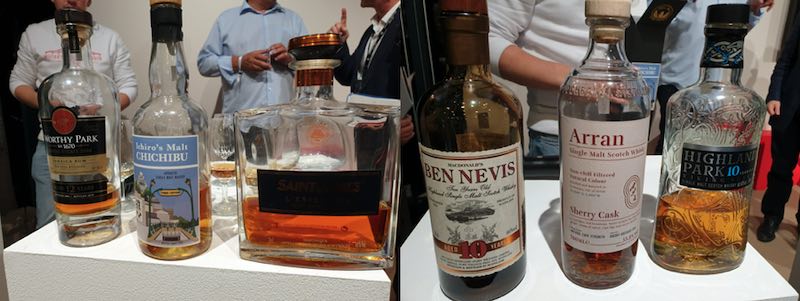
We tasted six bottles blind. Serge picked three expressions while Dave chose the other three. The three bottles by Serge were Highland Park 10, Ben Nevis 10 and Chichibu Pairs Edition 2019. Dave decided on Arran Sherry Cask (new release), Saint James Distillery Cuvee L’Essentiel 43% and Worthy Park 12 Years Old 2006 to 2018.
Blind tastings are always fun because you get a lot of different answers to the same question. For example, some attendees thought that Ben Nevis 10 was a Springbank due to its funky note. However, our friend, Javin Chia, is a Ben Nevis superfan and immediately identified it as Ben Nevis. His training as the distiller of Singapore’s first-ever whisky certainly did help too!
Chichibu Paris 2019 tasted almost Clynelish-like with waxiness lurking in the background. It has the fruitiness that we found in some modern Clynelish bottles, and it was a surprise to many that it was a Chichibu! Overall, the crowd had a balanced opinion of all the whisky. The Arran Sherry Cask, however, stood out for many, and it received slightly more votes than the others.
We enjoyed the day with all the whisky flowing freely for us. To conclude our day, we presented to you our picks for the day. Kindly note that they are in no particular order of merit.
Continue to read Part 2 – Trade Day of Whisky Live Paris here.
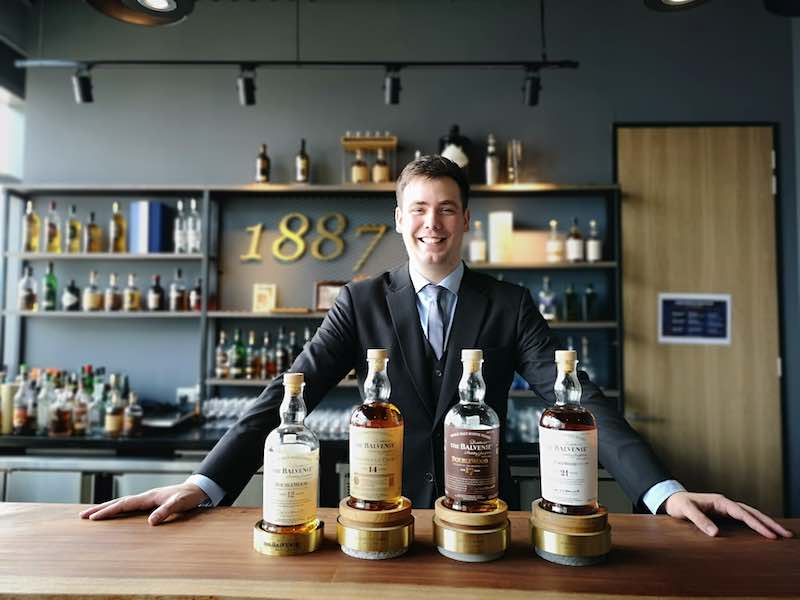
James Cordiner with the Balvenie Core Range of Products
I always get lucky to represent WhiskyGeeks when a handsome, young man comes to Singapore. Allow me to introduce Mr James Cordiner, Brand Ambassador of Southeast Asia for Balvenie Single Malt Scotch Whisky. James is not just another brand ambassador; he is the man after our hearts with his passion for whisky.
James is possibly the only brand ambassador that I have met so far to earn so many credentials in whisky production. He holds a General Certificate in Distilling, a distinction award in WSET 2 and is currently pursuing his Master Degree in Brewing and Distilling with Entrepreneurship at Heriot-Watt. He aims to complete the Master’s next year after his research project with William Grant and Sons.
Let’s hear more from the man himself.
James grew up in Speyside, Craigellachie, to be precise. As a young lad, he saw that the economy of the country revolves around the whisky industry. It was the biggest employer in Speyside, and naturally, most of his friends and neighbours have something to do with whisky. James was not interested in whisky because everyone else was. He wanted to be the best vet in Speyside, tending to the sheep and Highland coos.
However, fate tends to intervene.
When James came of age, he began to work in some of these distilleries during the summer as a tour guide. It was an excellent way to spend his summer, and he got to work with his friends. James also enjoyed all the interactions he had with the tourists. As he immersed himself in the world of whisky, James discovered that he loves to know more about whisky production. After university, James had a tough choice. He could put in another five years in Medicine and fulfilled his childhood dreams to be a vet, or he could put in just one year to complete a Master in Biomedical Science. He chose the latter.
During his time in university, James also began to work in Speyside whisky bars as a bartender. He also became the president of the whisky club. After graduation, he worked as a bartender for some months before joining Chivas Brother as a brand ambassador for the U.K.
In 2018, James decided to go back to school to obtain a Master’s degree in Brewing and Distilling. He wanted to add on to his knowledge on the technical part of whisky-making just so to satisfy his geeky side. He will complete the course once he finishes the research project that he will take on at William Grant and Sons in 2020.
Gemma Paterson, the Global Brand Ambassador of Balvenie, was at the Speyside Whisky Festival in May 2019, and James had a chance meeting with her. Their friendship goes way before this meeting, as Gemma knew James when he was working as a tour guide in Glenfiddich and also when he was working as a bartender for one of the whisky bars in Speyside. Gemma told him that there is a job for Balvenie and James naturally said YES! He went for the interview on Gemma’s recommendation and viola, here he is – the Southeast Asian Brand Ambassador for Balvenie!
James is the perfect person to be geeky with. He has all the credentials to teach us more about whisky. First, however, we need to know why he is so in love with whisky production. James has always been quite a little explorer as a child. His ambition to be a vet led him to study science and chemistry. While his grades eventually did not manage to get him a place in the course he wanted, he pursued a course in research into Family Medicine. The knowledge helped him tremendously when he decided to switch his career plans. Due to the switch, James also decided to put in more efforts and time to study what he chose to do for the rest of his life. He is genuinely excited to commerce his research at William Grant and Sons to earn the Master’s degree!
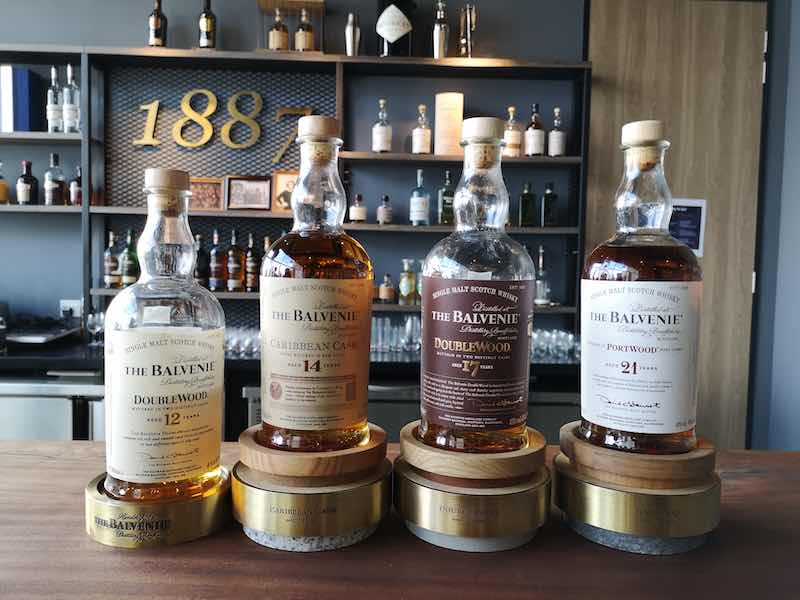
The Balvenie Core Range of Products
I had to ask the one question that everyone likes to ask me: What is the most important part of whisky production?
James looked at me seriously and said, “Well, every part counts!” He explained that many of the distilleries do use the same type of barley, the same yeast from the same company, and yet produces different kinds of whisky. Therefore, it is the uniqueness of all the parts, adding together that makes a whisky special.
As a geek myself, I could stop myself asking for more details about the production process.
Balvenie still has a traditional malting floor in which 10% of their barley is malted on-site. The remainder comes from professional malters. The malting process starts with two days of steeping the barley, before laying them on the floor for six days to germinate. Once the barley germinates, they go into the kiln for forty-two hours of drying. This malted barley then undergoes milling, and the end product is called grist.
The grist then goes into the mash tun. Each batch of mash uses 11.8 tonnes of milled barley. Mashing takes five and a half hours, with the first water at 68-degree Celcius, the second water at 75-degree Celcius, and the third water at 86 degree Celcius. At the end of the mashing process, the wort produced goes into the washbacks.
Balvenie has 15 washbacks that can hold 75,000 litres each. Fermentation takes place in the washbacks. However, the distillery only adds 53,000 litres of wort into each washback to aid fermentation and prevent overflowing. Two hundred sixty litres of yeast is added to the wort in the washback and left for 68 hours. After the fermentation is done, the wash is at 7-8% abv.
Next comes distillation. Balvenie has five wash stills and six spirits stills. The wash stills have a capacity of 9100 litres which the spirits stills hold 12,750 litres each. The total distillation hours are 15.5 – 16.5 hours. Balvenie takes the cut of the heart between 74% to 64% abv, pretty much like most other distilleries. Finally, 4250 litres of spirits will be obtained from the original 53,000 litres of wort.
It takes a total of 15 days to go from malting to distilling. Do note that Balvenie also has its cooperage.
Does terroir affect whisky? James thinks that it does but in very minimally, especially when compared to wines. “Things like water source are important. [It is] not so much [about] the flavours of the water going in, but the chemical balances, especially the PH, which will affect the later process, such as the fermentation and mashing.”
James goes on to explain that the flavours of the whisky come mostly from the cask, making up about 60-70% of the influence. Of course, when the whisky gets older, the impact of the cask gets stronger. Therefore, it is not really about terroir when it comes to flavours, but terroir does play a part in the entire process of whisky-making.
We also began to talk about barley, and if different barley affects the flavours of the new-make spirits. James commented that most distilleries use the same type of barley that is commercially available. Therefore, it would be hard to say that barley affects the flavours by a significant percentage. Whisky undergoes distillation, and the chemical process changes the character of the new-make based on the time, temperature and technics of each distillery. Barley should not make a big difference to whisky. It would, however, make a difference to beer, but that’s for another day.
The chat moved into the zone of whether older whiskies are better at this point, and I think we had it well covered.
“I’ve tasted a lot of old whiskies that are incredible. It depends on what flavours you like, so, as it gets older, it is going to get much more influence from the oak, tannins from the wood. I have a lot of people who tried the old whiskies, and they don’t like that sort of dryness from the oak itself. So it doesn’t mean that it is a better whisky. But [what] does tend to happen with age though, is sort of [the] mellowing out of the whisky, so you get the evaporation of the harsher alcohol and tends to become much smoother the older it is, which I think a lot of whisky connoisseurs and geeks really appreciate that sort of old woodly oakiness in the whisky.”
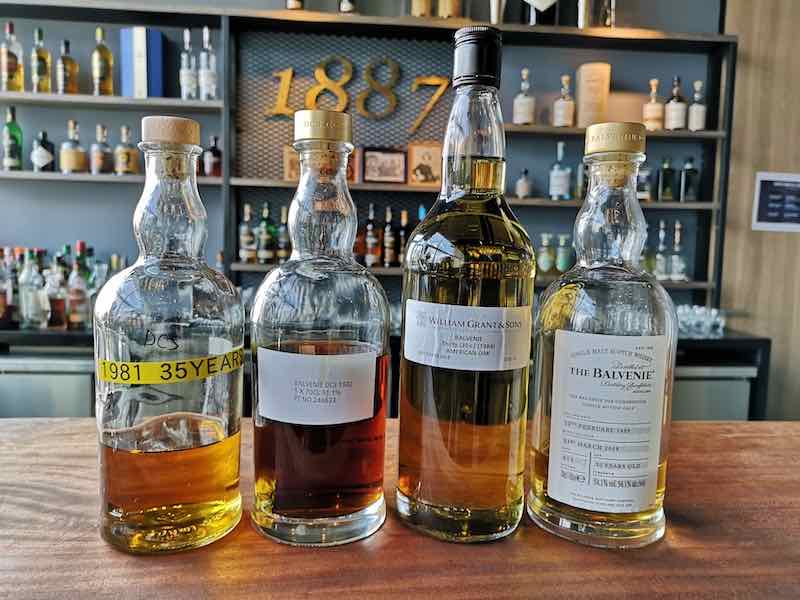
Balvenie DCS Selection
Since we were on the topic of older whiskies, we started talking about how Balvenie got everyone covered with their fantastic range of products. We get the core range of products from the Balvenie 12 Doublewood to the 21 Portwood for our daily drams and some exclusive cask strength whiskies for the occasions.
James then pulled out the big guns – the Balvenie DCS Selection. I do realise by now what a treat I was going to get, and I was trying very hard not to show my excitement. The DCS Selection that I tasted range from 1981 to 1985, with the youngest whisky being 30 years old.
After all four drams, I would rank them as such: 1985, 1984, 1981 and finally 1982. I love how each of them stands out on their own, with different characteristics but yet still showing the true Balvenie spirit. 1981, 1984 and 1985 are bourbon-matured while 1982 is sherry-matured.
I just had to ask this question because having just been back from Scotland; I know just how different Singapore is. James laughed and exclaimed, “The Weather!” He is truly a Scot to talk about the weather! James found the heat and humidity terrible to bear at first but he is slowly getting used to it. He will always miss the Scottish weather, but for now, he is ready to take on Southeast Asia to bring them more of Balvenie Single Malt Scotch Whisky.
We really must take our hats off this guy!
All the best to you, James, and we will be seeing you soon!

Credits: Balblair Distillery
Balblair distillery made it into the news recently for their change in packaging and labelling of their whiskies. Instead of vintages, the distillery decided to follow the conventional method of stating the age of the whisky on the bottle. It is a welcoming change for drinkers who are too lazy to count the years (like us)!
We wanted to see how things may change with the new packaging, and Lady Luck shines on us – SAMPLES! Our friend over at AsiaEuro kindly gave us some samples to try, and of course, we gladly took over. Who says no to whisky, right? Before we go into the tasting, let’s take a look at the history of the distillery.
Balblair was founded in 1790 by John Ross in the Highlands of Scotland. As a Highland distillery, Balblair uses water from the Ault Dearg burn. Even though the distillery moved its location in 1895 when Charles C Doig rebuilt it, the water source remains unchanged to this day. It is important to note that water source for a distillery is crucial, and we applaud the efforts that Balblair takes to maintain the integrity of its water.
John ran Balblair from 1790 to 1824 singlehandedly as a striving business. Andrew Ross, his son, joined him at the distillery in 1824 and it remained in the Ross family for another 70 years. In 1894, Alexander Cowan took over the tenancy of Balblair distillery. The business remained as a small-scale distillery until 1948, when Robert Cumming bought it. Robert expanded the distillery and increased production and ran the bigger distillery until he retired in 1970.
By this time, Balblair is known as an excellent Highland single malt whisky producer, and it is no wonder that the distillery attracted buyers. When Robert Cumming retired, he sold Balblair to Hiram Walker. Finally, Walker sold it to Inver House Distillers Limited in 1996, where it remained till this day.
We do not get a lot of information on the actual whisky production methods at Balblair as the information is not available. Let’s move on to the tasting notes!
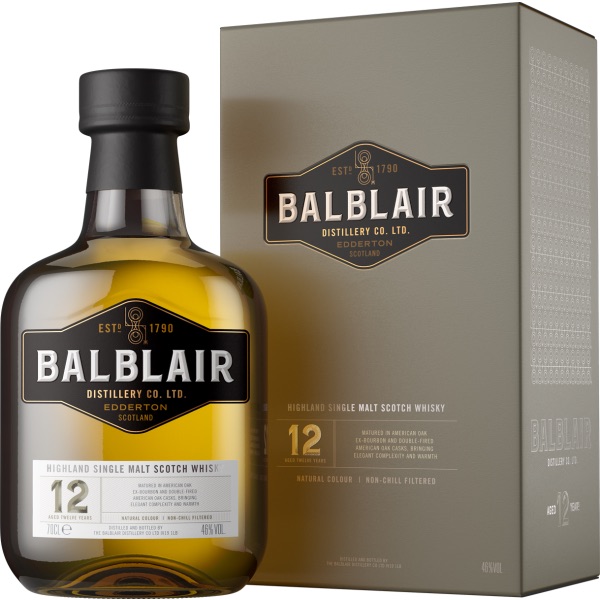
Credits: balblair.com
Our team was quite divided on our favourites after the tasting. Suffice to say, we enjoyed all three expressions, but the 15 Years Old did win the vote with a 2 out of 3. Have you tried these yet? What are your thoughts?
11311 Harry Hines Blvd
Dallas, TX, United States
(555) 389 976
dallas@enfold-restaurant.com
